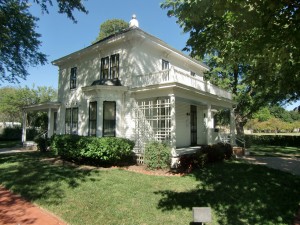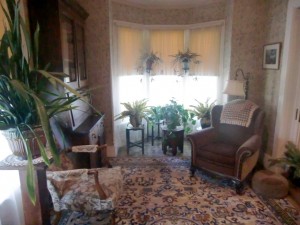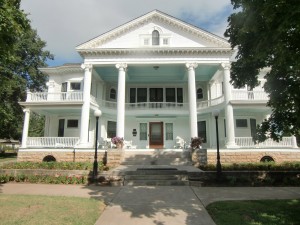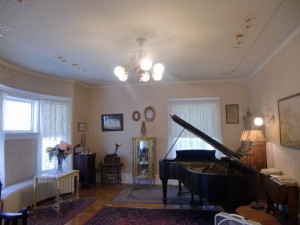ROAMING AROUND KANSAS – A DAY WITH PRESIDENT EISENHOWER
ROAMING AROUND KANSAS
This is the fourth in a series of articles about touring the state of Kansas
A DAY WITH PRESIDENT EISENHOWER
By Charles N. Stevens
Photos by Dolores Seidman
The sun rises like a brilliant copper ball on a chilly morning. We’re soon on our way, bumping across the tracks, to the Eisenhower Presidential Library, Museum and boyhood home. After a brief stay in the Visitors Center, we begin our tour of Eisenhower’s boyhood home, an unadorned white clapboard house where he lived for two years before leaving for West Point when he was 20. The simple two-story house gives us a good picture of his middle class upbringing. The house still sits where it always did.
We walk through the old rooms, finding them small but very comfortable or home-like. We walk by the piano, which each of Mrs. Eisenhower’s six boys had to learn to play. In the modest kitchen we learn that she had to bake nine loaves of bread each day to feed her brood. Since the Eisenhower home was on the “wrong” side of the tracks, the boys had to enter houses on the other side of the tracks at either the back or side doors when they visited friends there. I don’t know how they felt about that. When one thinks about the exalted status that Dwight Eisenhower attained, those “rules” seem ludicrous. Upstairs, where the boys lived, is roped off, but we had a good feel of the house from seeing the downstairs portion. I liked the way it looked, thinking I would have liked to have lived here.
Our home tour over, we now stroll across a wide grassy area to the museum. It is like walking across a college campus where there are no students, very quiet and peaceful. A light breeze that rustles the trees makes it even more pleasant. The museum deals primarily with World War II. It is very informative, but needs an upgrade as the exhibits need more light on them. Other exhibits outline Eisenhower’s life and times.
The library is a striking building , the inside being lined with polished marble. There are some exhibits upstairs, mainly about the Cold War, but what we don’t see are the thousands of documents behind closed doors that are only accessible to archivists and scholars. For the average tourist there isn’t much to see here.
As we continue our tour, we pass an attractive fountain before we enter the memorial chapel where President Eisenhower and his wife are buried in marble caskets. Stained glass windows cast shards of color on the glossy marble.
After returning to our hotel for a brief lunch, we are on our way again, this time to the amazing Seelye House, a magnificent house built in 1904 in Greek revival style. Four towering white columns support a Greek triangular pediment. When the basement is included, there are four stories to the house. Mr. Seelye gained his wealth by selling patent medicine and other household products. What is surprising about the house is that the interior is just as it was when the two Seelye daughters passed away at the age of 95. The daughters had lived their entire lives in the house and nothing has been changed. It is now just as the daughters left it, as if they had just stepped out for an errand. Even the plates, sewing machine and mason jars are just as they were. The very dramatic new owner takes us on a very enthusiastic tour of the house, even giving us a brief concert on the old piano. Interesting to us is small bowling alley in the basement, the bowling balls being fashioned out of walnut wood. One man from our group gives it a try, but is clearly no bowler.
After touring this grand house, we can’t help but compare it to the humble Eisenhower home located only a mile away.
It feels good to rest in our hotel for a while before going out to dinner. Dolores and I walk from our hotel a short distance to the Brookville Hotel which is not really a hotel but a famous restaurant. People drive for miles around to have dinner here. In typical Midwest style the waitresses treat us with kindness and enthusiasm as they lead us to our table. There is one dinner here—mounds of fried chicken, mashed potatoes, chicken gravy, creamed corn, biscuits, preserves, pickles, cottage cheese, Cole slaw all followed by ice cream. It is more than anyone can eat. We waddle back to our hotel room, too stuffed to even think about ever eating again.

"...we begin our tour of Eisenhower's home, an unadorned white clapboard house."

"We walk through the old rooms, finding them small but very comfortable or home-like."

"...the amazing Seelye House is a magnificent house built in l904 in Greek Revival style."

"What is surprising about the house is that the interior is just as it was when the two Seelye daughters passed away..."
MONTEREY PARK AUTHOR PUBLISHES 4th BOOK – Seeking More of the Sky: GrowingUp in the 1930’s:
Charles “Norm” Stevens, a 43 year resident of Monterey Park has recently published his 4th book: Seeking More of the Sky: Growing Up in the 1930’s. This is the story of a young boy growing up in Inglewood, California in the l930’s. This was a time during the depression when unemployment was affecting many and the banks were closed, while the clouds of war were gathering in Europe. But he was lucky enough to be raised in a loving family, the power of that love reflected throughout his stories.
Stevens is the author of three previous books about his experiences during WWII:
An Innocent at Polebrook: A Memoir of an 8th Air Force Bombardier (Story of his 34 bombing missions from his base at Polebrook, England over Germany and France)
The Innocent Cadet: Becoming A World War II Bombardier (A prequel to the first, telling of his training in the U.S. before going overseas into combat.)
Back from Combat: A WWII Bombardier Faces His Military Future from Combat: (This book details the time from when he returned from combat in England until the end of the war.)
He is known to the readers of The Citizen’s Voice as the author of Travel Log Articles including “Cruising the Rhine and Mosel”,” Best of the West”, “In Search of Snow” , “From Paris to Normandy on the Seine”, and “Exploring New York”. He is retired, having taught for 32 years, primarily in the Montebello Unified School District.
Those interested in purchasing an autographed copy of any of his books, may contact the author at 323-721-8230 or Normstevens24@gmail.com.



